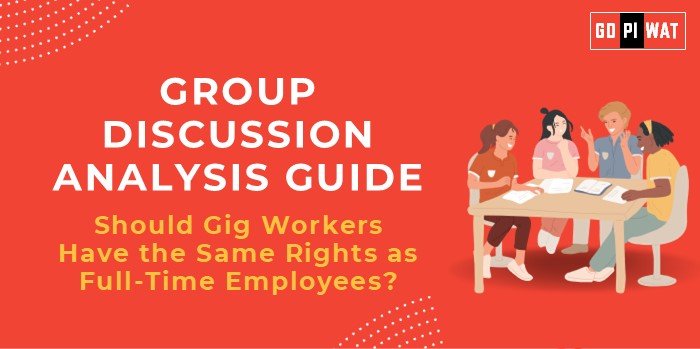📋 Group Discussion Analysis Guide: Should Gig Workers Have the Same Rights as Full-Time Employees?
🌐 Introduction to the Topic
- Opening Context: The gig economy has emerged as a cornerstone of modern employment, offering flexibility to both workers and businesses. However, it has sparked intense debates about the rights of gig workers versus full-time employees.
- Topic Background: The gig economy, powered by platforms like Uber, Zomato, and Amazon, has revolutionized employment by creating millions of jobs globally. Yet, while full-time employees benefit from job security and social protections, gig workers often face a lack of benefits like health insurance and retirement savings. This dichotomy raises critical questions about equity in the evolving job market.
📊 Quick Facts and Key Statistics
- 🌍 Global Gig Workforce: Over 150 million workers globally, with a $455 billion market valuation (2024).
- 🇮🇳 India’s Gig Economy: Employs 7.7 million workers, expected to grow to 23.5 million by 2030 (NITI Aayog, 2022).
- 📉 Social Security Gap: Only 5% of gig workers in India have access to health insurance or retirement benefits.
- ⚖️ Legal Reforms: The EU has proposed directives to improve gig worker rights by reclassifying their employment status.
👥 Stakeholders and Their Roles
- 🏛️ Government Bodies: Regulate policies and ensure fair treatment while balancing innovation in the gig economy.
- 📱 Gig Platforms: Drive innovation but face criticism for avoiding employee obligations.
- 👨💼 Workers: Seek equitable rights while valuing flexibility.
- 🌍 Unions and NGOs: Advocate for gig workers’ rights and monitor ethical practices.
🏆 Achievements and Challenges
✨ Achievements
- Economic Growth: Contributed $50 billion to India’s economy in 2022.
- Job Creation: Provided alternative employment for millions of semi-skilled and skilled workers.
- Workplace Flexibility: Gig workers enjoy autonomy over schedules and income.
⚠️ Challenges
- Legal Ambiguity: Many platforms classify gig workers as “contractors,” bypassing labor protections.
- Lack of Benefits: Absence of health insurance, paid leave, and retirement plans.
- Worker Exploitation: Cases of underpayment and unsafe working conditions.
🌍 Global Comparisons
- EU: Strong push for reclassification of gig workers with minimum wage laws.
- California, USA: AB5 legislation mandates gig workers to be treated as employees in specific cases.
📚 Case Study
- India: The Social Security Code (2020) aims to extend benefits like maternity leave and gratuity to gig workers, though implementation remains patchy.
💡 Structured Arguments for Discussion
- Supporting Stance: “Gig workers should have equal rights as they contribute significantly to the economy.”
- Example: “Classifying gig workers as employees can increase social security, reducing turnover rates and ensuring stability.”
- Opposing Stance: “Equalizing rights could stifle innovation and increase operational costs for platforms.”
- Example: “Imposing employee benefits might make platforms financially unviable, leading to job losses.”
- Balanced Perspective: “Recognizing gig workers as a hybrid category, offering tailored benefits while preserving flexibility.”
- Example: “An intermediary policy framework can address vulnerabilities without disrupting the gig model.”
🔍 Effective Discussion Approaches
🌟 Opening Techniques
- “With 7.7 million gig workers in India, it’s imperative to discuss their rights.”
- “While gig work offers flexibility, lack of rights undermines economic equity.”
💬 Counter-Argument Handling
- Acknowledge platforms’ concerns about costs.
- Suggest phased implementation to minimize disruption.
📈 Strategic Analysis of Strengths and Weaknesses
- Strengths: Flexibility, rapid job creation, and economic contribution.
- Weaknesses: Exploitation risks, lack of legal clarity.
- Opportunities: Policies for hybrid worker categories, global lessons.
- Threats: Rising discontent and legal battles.
📘 Connecting with B-School Applications
- Real-World Applications:
- Policy design in human resources and labor law.
- Research on the economic impact of gig work.
- Sample Interview Questions:
- “How can businesses balance profitability with ethical treatment of gig workers?”
- “Should governments intervene in the gig economy or leave it to market forces?”
- Insights for Students:
- Use gig economy trends for projects in HR or operations.
- Consider the social impact of labor policy in internships or research.


